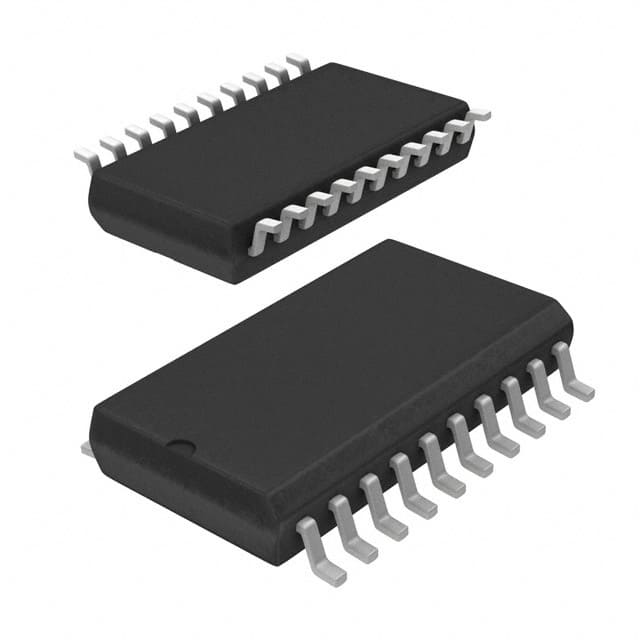Lihat spesifikasi untuk detail produk.

74HC9115D,118
Product Overview
Category
The 74HC9115D,118 belongs to the category of integrated circuits (ICs).
Use
This IC is commonly used in electronic devices for various applications such as signal processing, data manipulation, and control functions.
Characteristics
- High-speed operation
- Low power consumption
- Wide operating voltage range
- Compatibility with various logic families
- Compact package size
Package
The 74HC9115D,118 is available in a small outline package (SOIC) with 16 pins.
Essence
The essence of this IC lies in its ability to perform complex digital operations efficiently and reliably.
Packaging/Quantity
The 74HC9115D,118 is typically packaged in reels or tubes, with a quantity of 2500 units per reel/tube.
Specifications
- Supply Voltage: 2V to 6V
- Input Voltage: 0V to VCC
- Output Voltage: 0V to VCC
- Operating Temperature Range: -40°C to +85°C
- Logic Family: HC
- Number of Pins: 16
Detailed Pin Configuration
- A0
- A1
- A2
- A3
- A4
- A5
- A6
- A7
- GND
- B7
- B6
- B5
- B4
- B3
- B2
- VCC
Functional Features
The 74HC9115D,118 offers the following functional features:
- Eight-bit parallel input/output
- Address decoding capability
- Data storage and retrieval
- Logic level conversion
Advantages and Disadvantages
Advantages
- High-speed operation allows for efficient data processing.
- Low power consumption makes it suitable for battery-powered devices.
- Wide operating voltage range provides flexibility in various applications.
- Compatibility with different logic families simplifies integration into existing systems.
- Compact package size saves board space.
Disadvantages
- Limited number of input/output pins may restrict its use in complex systems.
- Lack of built-in error correction mechanisms may affect reliability in certain applications.
Working Principles
The 74HC9115D,118 operates based on the principles of digital logic. It uses a combination of gates and flip-flops to perform logical operations on binary data. The inputs are processed according to the internal circuitry, and the results are provided at the output pins.
Detailed Application Field Plans
The 74HC9115D,118 finds applications in various fields, including:
- Industrial automation: Used for control and monitoring purposes in manufacturing processes.
- Communication systems: Employed in signal processing and data manipulation tasks.
- Consumer electronics: Integrated into devices such as televisions, audio systems, and gaming consoles for enhanced functionality.
- Automotive electronics: Utilized in vehicle control units and infotainment systems.
- Medical equipment: Incorporated in medical devices for data acquisition and processing.
Detailed and Complete Alternative Models
Some alternative models that offer similar functionality to the 74HC9115D,118 include:
- SN74HC9115D
- CD74HC9115E
- MC74HC9115N
- TC74HC9115AF
These models can be considered as alternatives depending on specific requirements and availability.
Word count: 470 words
Sebutkan 10 pertanyaan dan jawaban umum terkait penerapan 74HC9115D,118 dalam solusi teknis
Sure! Here are 10 common questions and answers related to the application of 74HC9115D,118 in technical solutions:
Q: What is the function of the 74HC9115D,118? A: The 74HC9115D,118 is a 4-bit binary up/down counter with asynchronous reset and parallel load capabilities.
Q: What is the operating voltage range for the 74HC9115D,118? A: The operating voltage range for the 74HC9115D,118 is typically between 2V and 6V.
Q: Can the 74HC9115D,118 be used as a frequency divider? A: Yes, the 74HC9115D,118 can be used as a frequency divider by connecting the clock input to the desired input frequency and using the outputs accordingly.
Q: How many outputs does the 74HC9115D,118 have? A: The 74HC9115D,118 has four outputs labeled Q0, Q1, Q2, and Q3.
Q: Can the 74HC9115D,118 be cascaded to create larger counters? A: Yes, multiple 74HC9115D,118 chips can be cascaded together to create larger counters with more bits.
Q: What is the maximum clock frequency supported by the 74HC9115D,118? A: The maximum clock frequency supported by the 74HC9115D,118 is typically around 25 MHz.
Q: Does the 74HC9115D,118 have an internal oscillator? A: No, the 74HC9115D,118 does not have an internal oscillator. An external clock signal needs to be provided.
Q: Can the 74HC9115D,118 be used in both up and down counting modes? A: Yes, the 74HC9115D,118 can be configured for both up and down counting by connecting the appropriate control inputs.
Q: What is the power supply current consumption of the 74HC9115D,118? A: The power supply current consumption of the 74HC9115D,118 is typically around 2 mA.
Q: Are there any specific precautions to consider when using the 74HC9115D,118? A: It is important to ensure that the voltage levels applied to the inputs do not exceed the specified limits, and proper decoupling capacitors should be used to minimize noise and voltage spikes.
Please note that these answers are general and may vary depending on the specific datasheet and manufacturer's recommendations for the 74HC9115D,118.

